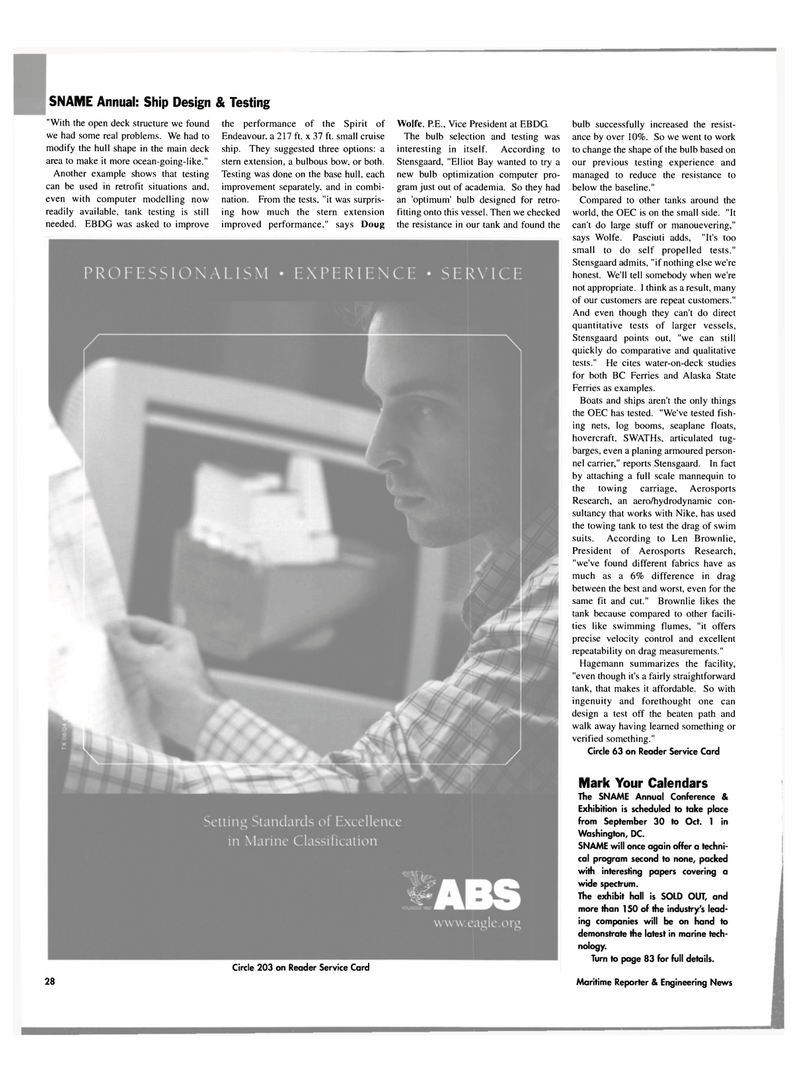
Page 29: of Maritime Reporter Magazine (September 2004)
Marine Propulsion Annual
Read this page in Pdf, Flash or Html5 edition of September 2004 Maritime Reporter Magazine
SNAME Annual: Ship Design & Testing "With the open deck structure we found we had some real problems. We had to modify the hull shape in the main deck area to make it more ocean-going-like."
Another example shows that testing can be used in retrofit situations and, even with computer modelling now readily available, tank testing is still needed. EBDG was asked to improve the performance of the Spirit of
Endeavour, a 217 ft. x 37 ft. small cruise ship. They suggested three options: a stern extension, a bulbous bow. or both.
Testing was done on the base hull, each improvement separately, and in combi- nation. From the tests, "it was surpris- ing how much the stern extension improved performance," says Doug
Wolfe, P.E., Vice President at EBDG.
The bulb selection and testing was interesting in itself. According to
Stensgaard, "Elliot Bay wanted to try a new bulb optimization computer pro- gram just out of academia. So they had an 'optimum' bulb designed for retro- fitting onto this vessel. Then we checked the resistance in our tank and found the bulb successfully increased the resist- ance by over 10%. So we went to work to change the shape of the bulb based on our previous testing experience and managed to reduce the resistance to below the baseline."
Compared to other tanks around the world, the OEC is on the small side. "It can't do large stuff or manouevering," says Wolfe. Pasciuti adds, "It's too small to do self propelled tests."
Stensgaard admits, "if nothing else we're honest. We'll tell somebody when we're not appropriate. I think as a result, many of our customers are repeat customers."
And even though they can't do direct quantitative tests of larger vessels,
Stensgaard points out, "we can still quickly do comparative and qualitative tests." He cites water-on-deck studies for both BC Ferries and Alaska State
Ferries as examples.
Boats and ships aren't the only things the OEC has tested. "We've tested fish- ing nets, log booms, seaplane floats, hovercraft, SWATHs, articulated tug- barges, even a planing armoured person- nel carrier," reports Stensgaard. In fact by attaching a full scale mannequin to the towing carriage, Aerosports
Research, an aero/hydrodynamic con- sultancy that works with Nike, has used the towing tank to test the drag of swim suits. According to Len Brownlie,
President of Aerosports Research, "we've found different fabrics have as much as a 6% difference in drag between the best and worst, even for the same fit and cut." Brownlie likes the tank because compared to other facili- ties like swimming flumes, "it offers precise velocity control and excellent repeatability on drag measurements."
Hagemann summarizes the facility, "even though it's a fairly straightforward tank, that makes it affordable. So with ingenuity and forethought one can design a test off the beaten path and walk away having learned something or verified something."
Circle 63 on Reader Service Card
Mark Your Calendars
The SNAME Annual Conference &
Exhibition is scheduled to take place from September 30 to Oct. 1 in
Washington, DC.
SNAME will once again offer a techni- cal program second to none, packed with interesting papers covering a wide spectrum.
The exhibit hall is SOLD OUT, and more than 150 of the industry's lead- ing companies will be on hand to demonstrate the latest in marine tech- nology.
Turn to page 83 for full details.
Maritime Reporter & Engineering News
Circle 203 on Reader Service Card 28

 28
28

 30
30
